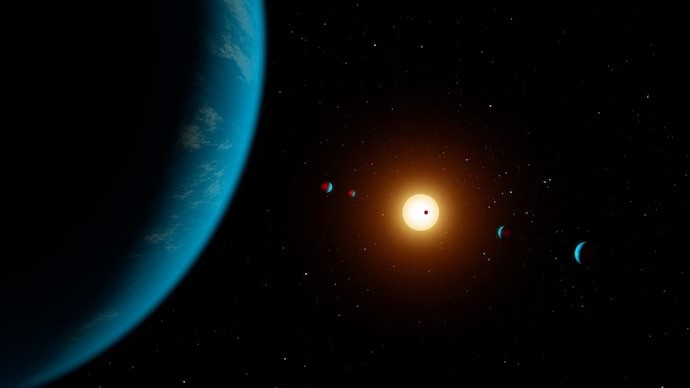Description

Disclaimer: Copyright infringement not intended.
Context
- Astronomers recently discovered six sub-Neptune planets orbiting a faraway star in a remarkable coordinated dance.
About Sub Neptune Planets
- These are the most prevalent types of planets found in our galaxy.
- They could be rocky worlds with thick atmospheres of hydrogen and helium gas, or rock and ice worlds with warm, water-rich atmospheres.
- These planets have radii that fall between Earth and Neptune.
Key Findings
- The star, known as HD110067, is around 100 light-years away in the constellation Coma Berenices and is roughly 20% less massive than our Sun.
- The six planets were discovered by detecting minute dimmings in the brightness of the star when each planet transited, or passed in front of, the star from Earth's perspective.
- These planets' orbital resonance, or synchronization, is such that their orbits have stayed steady for approximately 4 billion years.
- The newly discovered sub-Neptunes range from 9 to 2.9 times Earth's diameter and all seem to have substantial atmospheres.
- While none of the six planets lie within the traditional habitable zone—the region around a star where conditions might be right for liquid water and potentially life.
- They do possess atmospheres that could modify their surface temperatures, expanding the potentially habitable zone for such planets.

What are Exoplanets?
- Exoplanets are planets that orbit stars other than our sun and are outside of our solar system.
- The first confirmation of exoplanet identification occurred in
- According to NASA, approximately 5,000 exoplanets have been identified to date.
- According to scientists, there are more planets than stars since each star has at least one planet surrounding it.
- Exoplanets exist in a variety of sizes. They can be as large as Jupiter's gas giants or as small and rocky as Earth.
- They are also known to have a range of temperatures ranging from blazing hot to cold.
Discovery of Exoplanets
- Exoplanets are extremely difficult to observe directly using telescopes.
- The dazzling glare of the stars they orbit obscures them.
- As a result, astronomers hunt for and study exoplanets in different ways, such as observing the effects these planets have on the stars they circle.
- Scientists rely on indirect methods like the transit method, which analyses the dimming of a star when a planet passes in front of it.
- Other detection methods include gravitational microlensing, which involves bending and focusing light from a distant star as a planet passes between the star and Earth.
- Ae similar technology might theoretically be used to detect exoplanets around our Sun.
Significance
- Exoplanet research not only broadens our study of other solar systems but also assists us in piecing together information about our planetary system and its genesis.
- The most compelling reason to learn about them, however, is to find an answer to one of humanity's most deep and thought-provoking questions: are we alone in this universe?
- Another critical aspect of the research is determining the distance between an exoplanet and its host star.
- This assists scientists in determining whether or not a discovered world is habitable.
- When an exoplanet gets too close to a star, it may become too hot to support liquid water. If it is too far away, it may just have frozen water.
A large exoplanet orbits a very low-mass star
- The discovery of a Neptunemass exoplanet orbiting the very lowmass M dwarf star LHS 3154 puts theoretical ideas of planet formation to the test.
- The planet, which has at least 13 times the mass of Earth, orbits a star nine times less massive than the Sun, proving that tiny stars can sometimes host larger planets than previously assumed.
- Although huge planet candidates have been discovered in the vicinity of a few relatively lowmass dwarfs.

Facts About Neptune
- It is the last planet in our solar system.
- It is more than 30 times further away from the sun than Earth.
- Neptune and Uranus are quite similar.
- It consists of a dense fog of water, ammonia, and methane enveloping an earth-sized solid core.
- It has a hydrogen, helium, and methane
- Surface and Structure
- Neptune is an ice behemoth with six rings encircling him.
- It consists of a viscous soup of water, ammonia, and methane flowing over a solid core the size of Earth.
- It features a dense and windy atmosphere.
- Time on Neptune
- On Neptune, a day lasts 16 hours.
- Neptune travels so far around the sun that it takes 165 Earth years to complete one orbit.
|
PRACTICE QUESTION
Discuss the significance of the discovery of exoplanets in the context of our understanding of the universe and its implications for the search for extraterrestrial life.
|











